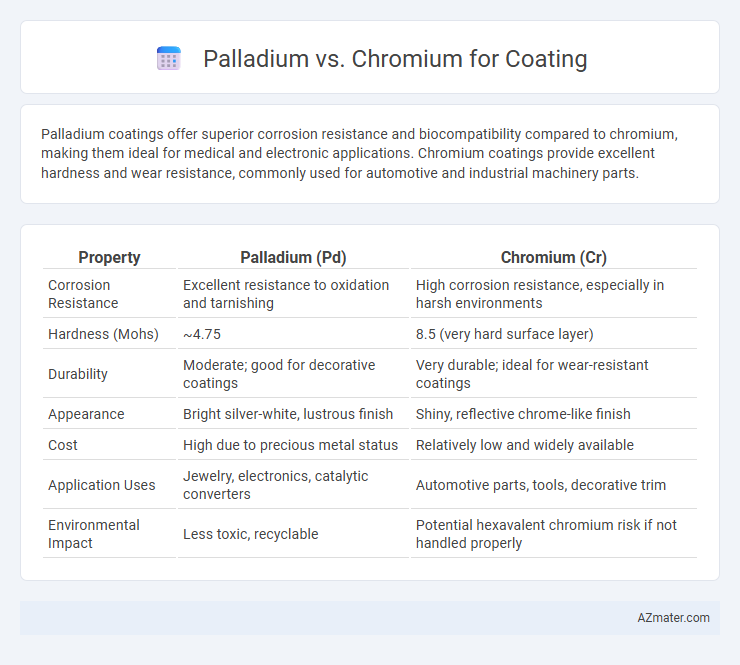Palladium coatings offer superior corrosion resistance and biocompatibility compared to chromium, making them ideal for medical and electronic applications. Chromium coatings provide excellent hardness and wear resistance, commonly used for automotive and industrial machinery parts.
Table of Comparison
| Property | Palladium (Pd) | Chromium (Cr) |
|---|---|---|
| Corrosion Resistance | Excellent resistance to oxidation and tarnishing | High corrosion resistance, especially in harsh environments |
| Hardness (Mohs) | ~4.75 | 8.5 (very hard surface layer) |
| Durability | Moderate; good for decorative coatings | Very durable; ideal for wear-resistant coatings |
| Appearance | Bright silver-white, lustrous finish | Shiny, reflective chrome-like finish |
| Cost | High due to precious metal status | Relatively low and widely available |
| Application Uses | Jewelry, electronics, catalytic converters | Automotive parts, tools, decorative trim |
| Environmental Impact | Less toxic, recyclable | Potential hexavalent chromium risk if not handled properly |
Introduction to Palladium and Chromium Coating
Palladium and chromium coatings serve distinct purposes in various industrial applications, with palladium valued for its excellent corrosion resistance and catalytic properties, often used in electronics and jewelry plating. Chromium coatings provide superior hardness, wear resistance, and a shiny, decorative finish, making them ideal for automotive and tooling industries. Selecting between palladium and chromium coatings depends on specific requirements like durability, appearance, and environmental resistance.
Chemical Properties and Composition
Palladium exhibits high chemical stability, exceptional corrosion resistance, and excellent catalytic properties, making it ideal for coatings exposed to harsh environments. Chromium offers superior hardness and oxidation resistance due to its ability to form a stable chromium oxide layer, enhancing durability in industrial applications. The composition of palladium coatings typically involves pure or alloyed palladium, while chromium coatings often consist of hard chromium plating with varying carbon content to optimize performance.
Application Industries and Uses
Palladium coatings excel in electronics and automotive industries due to their superior corrosion resistance and excellent conductivity, making them ideal for connectors, sensors, and catalytic converters. Chromium coatings dominate in aerospace and heavy machinery sectors, valued for their exceptional hardness, wear resistance, and ability to withstand high temperatures, often used in engine components and industrial tools. Both metals offer tailored surface solutions, with palladium favored for precision applications and chromium preferred for durability-intensive environments.
Durability and Corrosion Resistance
Palladium coatings offer superior corrosion resistance, especially in harsh chemical environments, outperforming chromium in preventing oxidation and tarnishing over time. Chromium coatings provide exceptional hardness and wear resistance, making them highly durable for mechanical applications. Palladium excels in maintaining long-term surface integrity without flaking or peeling, while chromium requires precise application to avoid brittleness and cracking under stress.
Aesthetic Differences and Surface Finish
Palladium coatings offer a bright, silver-white finish with excellent corrosion resistance, creating a smooth and lustrous surface ideal for high-end jewelry and luxury goods. Chromium coatings provide a harder, highly reflective mirror-like finish that resists tarnishing and wear, making it popular for automotive trims and household fixtures. The aesthetic difference lies in palladium's subtle and warm metallic sheen versus chromium's cooler, sharper brightness, influencing choice based on desired visual appeal and application durability.
Environmental Impact and Safety
Palladium coatings exhibit lower environmental toxicity compared to chromium, as palladium is less prone to releasing harmful hexavalent compounds during processing. Chromium plating, especially hexavalent chromium, poses significant health risks including respiratory issues and carcinogenicity, requiring strict industrial safety measures and extensive waste treatment. Sustainable manufacturing trends favor palladium due to its reduced hazardous waste generation and safer handling protocols in coating applications.
Cost Comparison and Market Trends
Palladium coating typically incurs higher costs than chromium due to its rarity and demand in luxury and electronics sectors, with prices fluctuating around $2,500 to $3,000 per ounce compared to chromium's $10 to $15 per pound, reflecting significant material cost differences. Market trends show increasing palladium usage driven by automotive catalytic converters and electronic components, while chromium remains dominant in industrial applications due to its corrosion resistance and cost-effectiveness. Price volatility in palladium markets often leads manufacturers to consider cost-performance trade-offs, balancing durability requirements with budget constraints in coating applications.
Plating Process and Techniques
Palladium plating offers superior corrosion resistance and excellent electrical conductivity, making it ideal for fine electronic components, while chromium plating provides exceptional hardness and wear resistance, preferred in automotive and industrial applications. The plating process for palladium typically involves electroless deposition techniques that ensure uniform coverage on complex geometries, whereas chromium plating employs electroplating with hexavalent or trivalent chromium baths for a durable, decorative finish. Control of bath composition, temperature, and current density is critical in both processes to achieve optimal adhesion, thickness, and surface quality.
Maintenance and Longevity
Palladium coatings offer superior corrosion resistance and require less frequent maintenance compared to chromium, making them ideal for high-wear applications. Chromium coatings provide excellent hardness and wear resistance but may develop micro-cracks over time, necessitating more regular upkeep. The longevity of palladium plating typically surpasses that of chromium due to its enhanced durability and resistance to oxidation.
Choosing the Right Coating for Your Needs
Palladium coating offers excellent corrosion resistance and a bright, smooth finish ideal for jewelry and electronic components requiring durability and aesthetic appeal. Chromium coating provides superior hardness and wear resistance, making it suitable for automotive parts, tools, and industrial applications demanding robust protection against abrasion. Selecting the right coating depends on balancing the need for corrosion resistance, wear protection, visual appearance, and cost efficiency tailored to the specific application environment.

Infographic: Palladium vs Chromium for Coating
 azmater.com
azmater.com